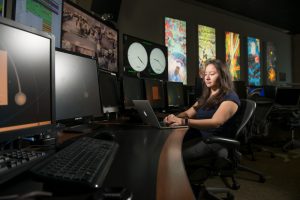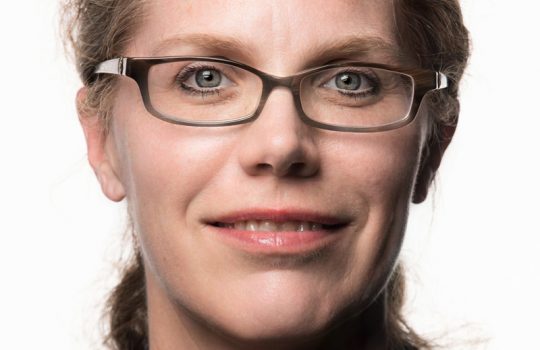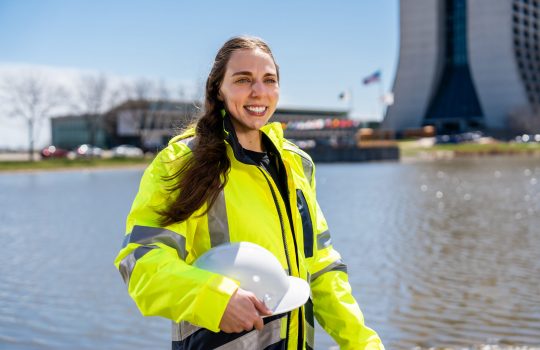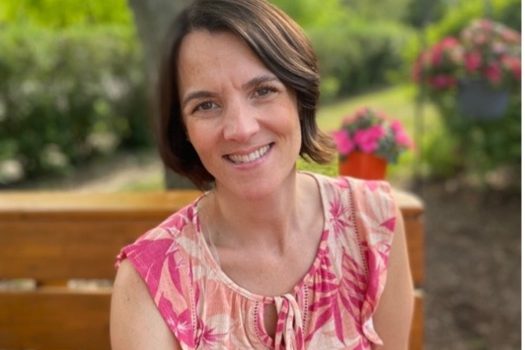Editor’s note: With Feb. 11 marking the International Day of Women and Girls in Science, female physicists, engineers and computer scientists from CERN and from Fermilab share their experiences of building a career in science.
Krista Majewski
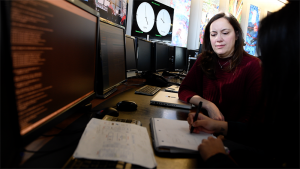
Krista Majewski: “What I like about programming is the breaking down of problems and being able to solve things.”
Krista Majewski came to Fermilab nine years ago as a software developer and now works in an operations role. She is a computing services specialist and part of the grid and cloud operations group, which manages computing clusters for the CMS experiment and other intensity frontier experiments at the lab.
“My typical day would be maintaining the services that our group is responsible for and the machines that they run on. So if there are problems with a computing cluster where a user can’t run their jobs, or they’re trying to run on resources on the grid and they’re unable to, then our group would be responsible for helping debug some of those issues,” Majewski said.
Her path to programming at Fermilab has been winding. After receiving a degree in biomedical engineering, she went to work doing web development and programming for a large consulting firm, then moved to the financial industry. But programming called her back, and she earned a master’s degree in computer science to start her new career.
For Majewski, programming is similar to something she enjoyed as child: solving puzzles.
“I think it’s a skill that you use in a lot of different ways,” Majewski said.
Sofia Vallecorsa

Sofia Vallecorsa: “Technology is part of society, so learning computing can be empowering.” Photo: CERN
Italian physicist Sofia Vallecorsa always knew that she wanted to study science. Her mother was a physicist and her father a mathematician, so it felt natural to her to choose a physics degree. During her studies she saw computing simply as a tool, but as time went on her love for computing grew. Computing was interesting because it was challenging.
“Coding reminded me of being a kid playing with a challenging problem. It felt so rewarding when I found the solution,” Vallecorsa said.
After her studies she moved into computing and now works in the CERN Physics Department providing software tools for the experimental physicists. Coming to computing via a different background meant making more effort to learn things for herself. But this taught her to face challenges one step at a time to reach her goal.
“I use a lot of machine learning in my work, and this was something that I had to learn from scratch. Yet it is so interesting and important to many fields and has really expanded my horizons to work with experts outside of particle physics,” she said.
Margherita Vittone-Wiersma
Margherita Vittone-Wiersma came to Fermilab as a physicist in February 1985. Together with a group of researchers from Italy’s Institute of Nuclear Physics, she began a new experiment called E 687. But she soon learned that she preferred working on data acquisition and the many methods to store and access the huge amount of data coming out of science experiments. What was once mere megabytes of data is now terabytes of information — and experimental physicists need to be able to retrieve stored data and monitor data coming from the detectors in real time.
“It’s been an incredible change in scale of the amount of data that is handled by computers and has to be analyzed by the physicists” Vittone-Wiersma said.
Vittone-Wiersma migrated from physics to her new role in computing through lots of hands-on learning and classes in different programming languages and software development offered at Fermilab. She officially joined the lab’s Computing Division in 1989.
“It’s a great experience to work with the physicists,” she said. Together physicists and computing experts iterate over tools “to make sure that everything is working the way they expect. It’s very rewarding.”
Sima Baymani
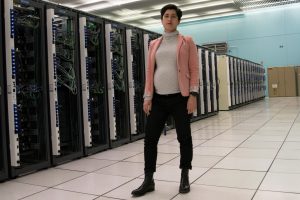
Sima Baymani: “You can work all over the world, because programming is the same everywhere. The choices you have are endless.” Photo: CERN
Computer science engineer Sima Baymani was born in Iran before her family fled war when she was young to start a new life in Sweden. Her parents were academics, and Baymani and her sisters were always encouraged to learn more about everything. Her mother, a physicist, had to restart her career in Sweden and chose to pursue database management and programming. Her enjoyment of her job, coupled with an inspiring Danish mathematics teacher, were two factors that helped lead Baymani towards studying computer science.
“In school I was interested in almost all subjects. But I can see that the IT boom in Sweden had an effect on me and on other women, because when we started university it was one of the peaks of women studying computer science,” she said.
At university, Baymani wanted to understand how computers worked, so she specialized in hardware and embedded systems. After graduation she worked as an independent consultant for 10 years before joining CERN.
“You can work all over the world, because programming is the same everywhere. If you value freedom and flexibility then programming is something for you – it’s really something that anyone can pursue if they want to,” Baymani said.
She has encountered challenges in fighting gender and ethnic stereotypes, and often felt that she had to work harder to prove herself. Yet part of her joy of programming is collaborating with colleagues to find creative solutions to complex problems and to develop new products or new functionality.
“Technology is everywhere in our society; the problems and solutions you can work with creatively are endless,” she said.
Jeny Teheran
Jeny Teheran is a security analyst and cybersecurity researcher at Fermi National Accelerator Laboratory. That means keeping up with and taking care of hardware and software vulnerabilities so that the experiments can carry out their science in a secure manner. It’s a fast-paced job where you have to come with the best solution you can put in place, right in the moment. “I would recommend this job because it challenges you. It pushes you to be on top of your game. You have to improve your analytical skills; you have to react fast; you have to communicate better,” Teheran said. Teheran came to Fermilab from the Caribbean coast of Colombia. She grew up in a house with few toys but lots of books, and says she has always felt close to science. With a degree in systems and computing engineering, she arrived at Fermilab four years ago as an intern to work on the offline production team for neutrino experiments. A year later, she was hired as a security analyst. “And I’m loving it,” she said.
Evangelia Gousiou
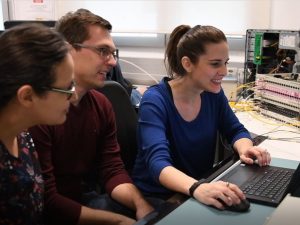
Evangelia Gousiou (right): “Nothing beats the rush you get when something that you designed works for the first time,” she said. Photo: Jacques Fichet/CERN
Electronics engineer Evangelia Gousiou began her career studying IT and electronics in Athens, Greece, before beginning an internship at a manufacturing plant in Thailand. She came to CERN for a one-year position, and now, 10 years later, is still at CERN enjoying a job that is never boring.
“Work is never repetitive, which makes it very rewarding. I usually follow a project through all its stages from conception of the architecture, to the coding and the delivery to the users of a product that I have built to be useful for them. So I see the full picture and that keeps me engaged,” Gousiou said.
For Gousiou, to be a good electronics engineer means knowing a range of disciplines, from software to mechanics. There is also the human aspect, as she works daily with people from many different cultures.
At school, her favorite subjects were math and physics, as she enjoyed finding out how things worked, yet Gousiou never dreamed of being an engineer when she grew up. When the time came to choose what to study, she felt that engineering would be something interesting to study and future-proof, and then she got hooked and now can’t imagine doing anything else.
“I would recommend engineering professions for their intellectual challenge and the empowerment that they bring,” she beams.


